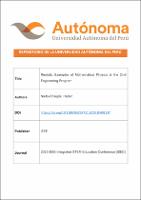| dc.contributor.author | Nieto-Chaupis, Huber | |
| dc.date.accessioned | 2024-04-04T22:51:23Z | |
| dc.date.available | 2024-04-04T22:51:23Z | |
| dc.date.issued | 2023 | |
| dc.identifier.uri | https://hdl.handle.net/20.500.13067/3082 | |
| dc.description.abstract | Traditionally, a first course of physics at the civil engineering program is planned to expose basics of classical mechanics. The lack of a solid mathematical level emerges a first obstruction to go through a deeply treatment of cases that might be important motivations to enrich the theoretical component of program towards a solid professional formation even in the territory of research. This paper tries to present methods from the Mathematical Physics to model the problem of seismic waves that affect buildings. With this theory student might to mature ideas to design computational scenarios based at the Mathematical Physics to improve security at tall buildings. | es_PE |
| dc.format | application/pdf | es_PE |
| dc.language.iso | eng | es_PE |
| dc.publisher | IEEE | es_PE |
| dc.rights | info:eu-repo/semantics/restrictedAccess | es_PE |
| dc.rights.uri | https://creativecommons.org/licenses/by-nc-nd/4.0/ | es_PE |
| dc.subject | Civil engineering | es_PE |
| dc.subject | Earthquakes | es_PE |
| dc.subject | Bessel | es_PE |
| dc.title | Realistic Examples of Mathematical Physics at the Civil Engineering Program | es_PE |
| dc.type | info:eu-repo/semantics/article | es_PE |
| dc.identifier.journal | 2023 IEEE Integrated STEM Education Conference (ISEC) | es_PE |
| dc.identifier.doi | https://doi.org/10.1109/ISEC57711.2023.10402137 | es_PE |
| dc.subject.ocde | https://purl.org/pe-repo/ocde/ford#2.02.04 | es_PE |


